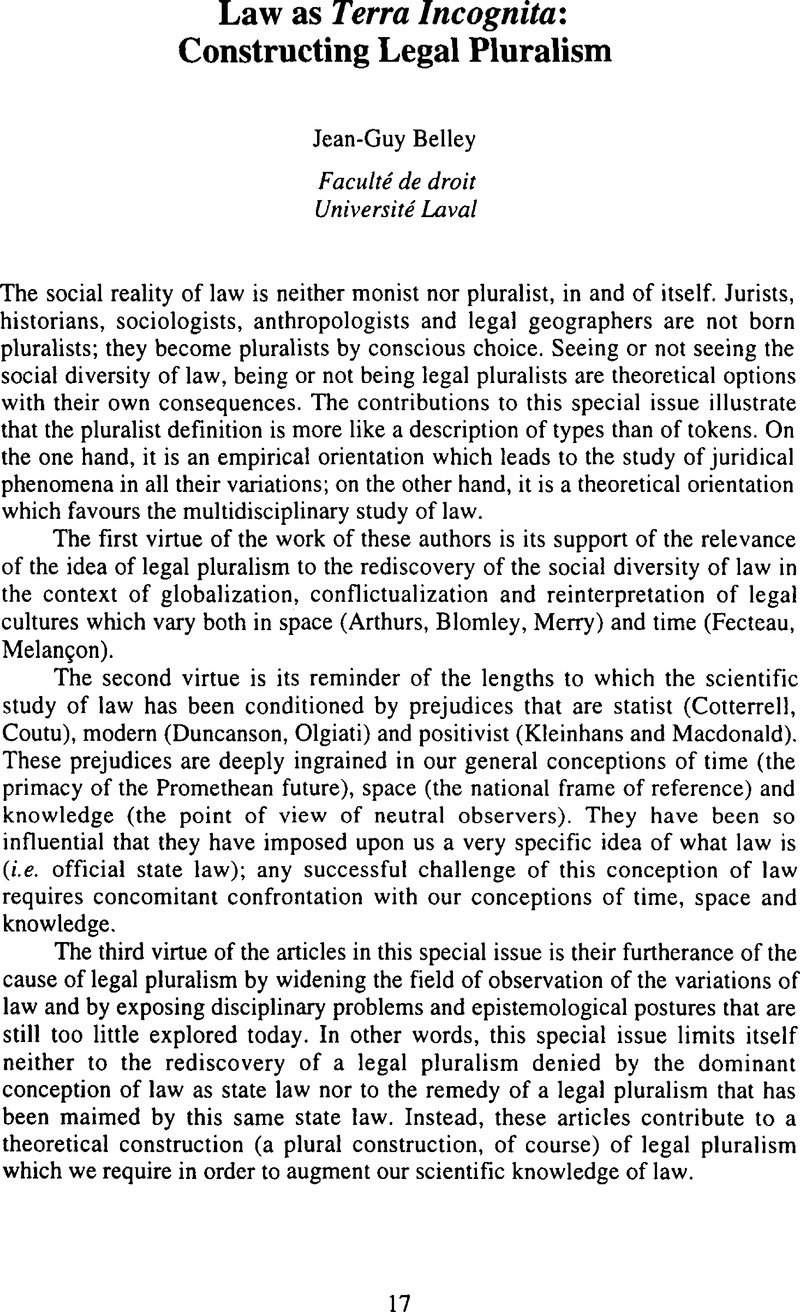Published online by Cambridge University Press: 18 July 2014

1. Pospisil, L., “Legal Levels and Multiplicity of Legal Systems in Human Societies” (1967) 11 The Journal of Conflict Resolution 2CrossRefGoogle Scholar.
2. Moore, S. Falk, “Law and Social Change: The Semi-autonomous Social Field as an Appropriate Subject of Study” (1973) 7 Law and Society Rev. 719CrossRefGoogle Scholar.
3. Griffiths, J., “What is Legal Pluralism?” (1986) 24 Journal of Legal Pluralism 1 at 38Google Scholar.
4. For the scientific study of law's social reality envisioned as a multiplicity of layers, the framework presented by Gurvitch remains unsurpassed and unjustly neglected. Gurvitch, G., Éléments de sociologie juridique (Paris: Aubier, 1940) at 167ff.Google Scholar; Gurvitch, G., Sociology of Law (London: Routledge, 1947) at 174ffGoogle Scholar. For a synthesis, see Belley, J.-G., “Georges Gurvitch et les professionnels de la pensée juridique” (1986) 4 Droit et Société; 353CrossRefGoogle Scholar.
5. In his Essais sur la théorie de la science, Max Weber unabashedly maintained that all scientific knowledge is based upon a “unilateral analysis of the cultural reality.” Extracts quoted in Bourdieu, P. et al. , eds., Le Métier de sociologue: Préalables épistémologiques (Paris: Mouton, 1968) 196CrossRefGoogle Scholar.
6. For an excellent elaboration of the concepts used, which has been overlooked until recently, see Chiba, M., Legal Pluralism: Toward a General Theory through Japanese Legal Culture (Tokyo: Tokai University Press, 1989) at 141ffGoogle Scholar (the concepts of “identity postulate” of a legal culture and “functional complement to strict law”); von Benda-Beckmann, F., “Comment on Merry” (1988) 22 Law and Society Rev. 897CrossRefGoogle Scholar; von Benda-Beckmann, F., “Changing Legal Pluralisms in Indonesia” (Paper presented to the 6th International Symposium Commission on Folk Law and Legal Pluralism, Ottawa, 15–18 August 1990)Google Scholar (legal pluralism as “normative construct,” more or less official policy of external relations with other legal orders).
7. Belley, J.-G., “L'État et la régulation juridique des sociétés globales: Pour une problématique du pluralisme juridique” (1986) 18 Sociologie et sociétés 11CrossRefGoogle Scholar.
8. Romano, S., L'Ordre juridique (Paris: Dalloz, 1975)Google Scholar. In legal theory, the work of Santi Romano has been pursued by Chevalier, J., “L'Ordre juridique” in CURAPP, Le Droit en procès (Paris: PUF, 1984) 7Google Scholar. See also Rigaux, F., “Le Droit au singulier et au pluriel” (1982) 9 Revue interdisciplinaire d'études juridiques 1CrossRefGoogle Scholar. Santi Romano's theory was explored in a sociological optic in Rocher, G., “Pour une sociologie des ordres juridiques” (1988) 29 Cahiers de droit 91CrossRefGoogle Scholar. The concept of “legal relevance” guided the empirical research of Croteau, R., La Programmation musicale à la radio M.F.: La production d'ordres juridiques. Master's thesis in Sociology, Université de Montréal, 1995Google Scholar.
9. Petersen, H. & Zahle, H., eds., Legal Polycentricity: Consequences of Pluralism in Law (Aldershot: Dartmouth, 1995)Google Scholar.
10. Teubner, G., Breaking Frames: The Global Interplay of Legal and Social Systems (London: London School of Economics, 1995)Google Scholar [unpublished].
11. De Munck, J. & Lenoble, J., “Droit négocié et procéduralisation” in Gérard, P., Ost, F. & van de Kerchove, M., eds., Droit négocié, droit imposé? (Brussels: Facultés universitaires Saint-Louis, 1996) 171CrossRefGoogle Scholar.
12. Hage, J. & Powers, C. H., Post-Industrial Lives: Roles and Relationships in the 21st Century (Newbury Park: Sage, 1992)CrossRefGoogle Scholar.
13. A psycho-social pluralist project has been expressly undertaken by M. Chiba, “Legal Pluralism in Mind: A Non-Western View” in Petersen & Zahle, supra note 9 at 71. A political sociology of law which suggests the principle of a “multivocal regulation” of contemporary societies has been proposed by Commaille, J., L'Esprit sociologique des lois: Essai de sociologie politique du droit (Paris: PUF, 1994)CrossRefGoogle Scholar.
14. de Sousa Santos, B., Toward a New Common Sense: Law, Science and Politics in the Paradigmatic Transition (New York: Routledge, 1995) at 477Google Scholar.
15. Thuot, J.-F., “Declin de l'État et formes postmodernes de la démocratic” (1994) 26 Revue québécoise de science politique 75Google Scholar. For a critique of conventional political theories of federalism from a legal pluralist perspective, see Macdonald, R. A., “Metaphors of Multiplicity: Civil Society, Regimes and Legal Pluralism” (1997) Arizona Journal of International and Comparative LawGoogle Scholar [forthcoming].
16. This conceptual dissolution is produced not only when one compares state law with other normative phenomena with which it is more or less similar (the issue of legal pluralism), but also when one studies law (state or otherwise) in its relations with other cultural spheres like religion, morality, ethics or science (the issue of internormativity). See, in this regard, Belley, J.-G., ed., Le Droit soluble: Contributions québécoises à l'étude de l'internormativité (Paris: LGDJ, 1996)Google Scholar.
17. See Greenhouse, C. J., “Dimensions spatio-temporelles du pluralisme juridique” (1989) 13 Anthropologie et sociétés 35CrossRefGoogle Scholar; Ost, F., “Temporal Pluralism and Legal Relativism: Contributions to the Study of Delegalisation” in Daintith, T., ed., Law as an Instrument of Economic Policy: Comparative and Critical Approaches (Berlin: Walter de Gruyter, 1988) 322CrossRefGoogle Scholar; Ost, F., “Les Multiples temps du droit” in Le Droit et le futur (Paris: Travaux de recherches de l'Université de droit, d'économie et de sciences sociales de Paris, 1985) 115Google Scholar; Ost, F., “Mémoire et pardon, promesse et remise en question: La déclinaison éthique des temps juridiques” in Côté, P.-A. & Frémont, J., eds., Le Temps et le droit (Cowansville: Y von Blais, 1996) 15Google Scholar.
18. This special issue is a collective work. I thank the authors of the articles, the anonymous reviewers and the four colleagues who, alongside Roderick Macdonald and myself, contributed to assuring the thematic coherence of the issue: Ruth Buchanan, (Law, UBC), Louis Marquis (Law, Université de Sherbrooke), Wes Pue (Law, UBC) and Guy Rocher (Law, Université de Montréal). I also thank Martha-Marie Kleinhans (Law, McGill) for translating this introductory paper.